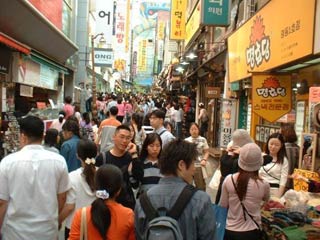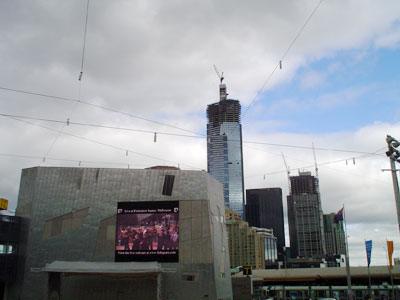About Synesthesia Urbania
Synesthesia Urbania (SU) is a collaborative audio/visual performance requiring public participation through input from mobile devices and incorporating live performance of electro-acoustic sounds and visuals.
The performance is the culmination of an online dialogue between public participants from Myoung-Dong (Seoul, South Korea) and the city of Melbourne (Australia) and commissioned artists contributing compositional elements to the final work.

Myoung-Dong, Seoul (Photo: James Burron)

Federation Square, Melbourne (Photo: Garton)
Collaborators identify, by way of photos, text, video and audio clips, diverse cultural references in their respective countries which are sent via a multimedia messaging system (MMS) gateway to a common online workspace. In addition, they are encouraged to track signs of homogenisation and vectors of similarity that participants may recognise regardless of ethnicity and language.
All elements of the work are collated within an online workspace called the SU Commons and will be covered by a Creative Commons copyright license that allows them to be copied and reused for any creative purpose. Artists will develop their contributions, strengthen collaborations, devise systems and strategies via the Moblog. This process will culminate in face-to-face pre-production in Korea and the public, collaborative performance.
SU will be performed by Melbourne based "Terminal Quartet" (Andrew Garton, Ollie Olsen, Steve Law, John Power) in collaboration with a cross-genre sampling of Korean musicians and video artists commissioned by Art Center Nabi and produced by Toy Satellite in association with the Australian Embassy Seoul.
Early adopters
Korea is a world leader in the up-take of broadband technologies and mobile devices are near ubiquitous within the public sphere. Organisations such as Labour Media have assisted in the public up-take of internet services and with MEDIAct have contributed to the establishment of over 100 video production collectives, producing locally made broadband content throughout South Korea.
Jinbonet, a Korean community communications provider, are advocates on information technology rights as well as advancing more liberal intellectual property licences through the adoption of Creative Commons and copy left ideologies for Korean based media makers.
In addition, Sookmyung University have hosted information technology and new media workshops for women working in marginalised communities throughout South-east Asia in collaboration with Toy Satellite and other members of the international Association for Progressive Communications.
It is in this climate that Toy Satellite seeks to develop collaborative projects integrating new technologies within a dynamic culture of digital technology adopters.
Culture, technology & public art
Korea's deep cultural traditions in performance, particularly that of Sinawe, improvisation techniques that grew from shamanistic cultural practices some 2500 years old, finds Toy Satellite engaging further with a society in which the artistic practices of both countries can influence and enrich each others contributions within participatory processes that forge creative alliances with both the public and artists alike.
Synesthesia Urbania not only contributes to the new technology applications that are emerging from cross-cultural expressions, it is a methodology for the creation of artworks resulting from engagement with the public. It contributes to an international community of new media artists exploring new forms of public art devised with communication technologies, a concept that is often referred to as the emergent "collective commons".
Outcomes
The creative application of near ubiquitous technologies in Korea and new multimedia messaging systems in Australia is a public art conduit Toy Satellite will seek to develop through Synesthesia Urbania (SU). This will see the production of a tangible and compelling collaborative performance, providing meaning and ownership of the end results to all participants, not only the artists that will facilitate this process.
The SU Moblog will provide a template for further projects in the region, particularly within a multilingual environment. It will be a test case for the dynamic integration of English and Asian character within an online participatory environment.
The SU Mesh builds on prototypes developed by Toy Satellite in collaboration with video artist, John Power, and will result in not only a performance tool that can be utilised for ongoing projects of this nature, it can be situated within a gallery environment for public display and use.
Both Korea and Australia have new systems, built within current copyright law, that provide support for the collective ownership of creative processes and products whilst sustaining copyright protections. Toy Satellite aims to establish the first collaborative public artwork in Australia to employ Creative Commons licensing with a view to informing and collaborating with various agencies yet to support the scheme (i.e. Australian Performing Rights Association, Australian Copyright Council).
Synesthesia Urbania, as the title suggests, evokes by way of the collaborative workspace and public performance, a simultaneous exploration of two different societies, two very different traditions, identifying each other through the urban environment in spite of the theatre of sameness, not difference, that is to be found in the homogenisation of contemporary cultures, "a cheapening of the local in favour of the general" (Community, Culture and Globalisation - Adams, Goldberg 2002).
Acknowledgements
Toy Satellite thanks the Association for Progressive Communications and Australian Network for Art and Technology for their support towards the 1 - 12 August 2005 Synesthesia Urbania research trip to Seoul.
Toy Satellite acknowledges the Australian Centre for the Moving Image and NovaMedia for their support and encouragement throughout the early development of this project.


